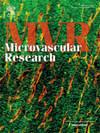近红外光谱反应性充血的性别差异:脂肪组织和去饱和率的影响。
IF 2.7
4区 医学
Q2 PERIPHERAL VASCULAR DISEASE
引用次数: 0
摘要
近红外光谱(NIRS)反应性充血结果的性别差异先前有报道,女性通常具有较低的再灌注斜率。性别差异也被报道为脂肪组织厚度(ATT),影响近红外光谱信号,和闭塞期间的去饱和,这可能对再灌注斜率起作用。我们的目的是比较反应性充血期间经统计学校正和未经统计学校正的再灌注斜率的性别差异。方法:23名女性和22名男性受试者完成前臂和大腿血管闭塞试验。超声测量ATT。采用带和不带去饱和斜率(StO2%/s)和ATT作为协变量的线性模型比较两性间的再灌注斜率(StO2%/s)。结果为平均或平均差异[95 % CI]。结论:性别差异可能与不同的ATT和去饱和率有关。在估计近红外反应性充血的性别差异时,研究人员可能会考虑调整ATT和/或去饱和率。本文章由计算机程序翻译,如有差异,请以英文原文为准。
Sex differences in near-infrared spectroscopy reactive hyperemia: Influence of adipose tissue and desaturation rate
Sex differences in near-infrared spectroscopy (NIRS) reactive hyperemia outcomes have been previously reported, with females generally having a lower reperfusion slope. Sex differences have also been reported for adipose tissue thickness (ATT), which affects the NIRS signal, and desaturation during occlusion, which may act on reperfusion slopes. We aimed to compare statistically adjusted and unadjusted sex differences in reperfusion slope during reactive hyperemia.
Methods
23 female and 22 male participants completed forearm and thigh vascular occlusion tests. ATT was measured via ultrasound. Reperfusion slopes (StO2%/s) were compared between sexes using linear models with and without desaturation slope (StO2%/s) and ATT as covariates. Results are mean or mean difference [95 % CI].
Results
In both limbs, females had greater ATT (p < 0.001). Desaturation rate was lower in females for the leg (−0.02 [−0.03, −0.01]), but not the arm (0.00 [−0.01, 0.02]). Unadjusted, males had greater reperfusion slope in the leg (females = 0.91 [0.70, 1.11], males = 1.59 [1.33, 1.85], p < 0.001) but not the arm (females = 1.60 [1.36, 1.84], males = 1.57 [1.29, 1.86], p = 0.874). Sex differences were not observed in adjusted models (both p ≥ 0.631). ATT and desaturation slope explained unique variance in the leg (both p ≤ 0.001), but only desaturation slope did in the arm (p < 0.001).
Conclusion
Sex differences may have been related to differing ATT and desaturation rates. Researchers may consider adjusting for ATT and/or desaturation rate when estimating sex differences with NIRS reactive hyperemia.
求助全文
通过发布文献求助,成功后即可免费获取论文全文。
去求助
来源期刊

Microvascular research
医学-外周血管病
CiteScore
6.00
自引率
3.20%
发文量
158
审稿时长
43 days
期刊介绍:
Microvascular Research is dedicated to the dissemination of fundamental information related to the microvascular field. Full-length articles presenting the results of original research and brief communications are featured.
Research Areas include:
• Angiogenesis
• Biochemistry
• Bioengineering
• Biomathematics
• Biophysics
• Cancer
• Circulatory homeostasis
• Comparative physiology
• Drug delivery
• Neuropharmacology
• Microvascular pathology
• Rheology
• Tissue Engineering.
 求助内容:
求助内容: 应助结果提醒方式:
应助结果提醒方式:


